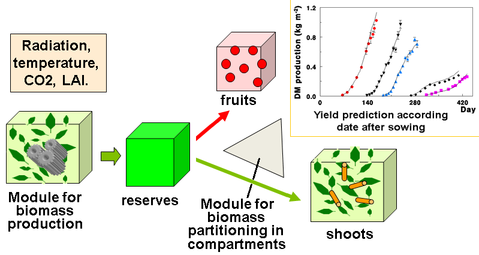Preliminary Course.
Plant and crop Models
PBM (1)
Process-based models
-
Process-based models or process-based crop models so-called PBM, are designed to predict yields from the simulation of plant functioning
according to endogenous plant properties and environmental conditions.
The harvest index is a typical output of such models,
defined by the weight of the harvested organ divided by the plant weight at the overall crop level.
A process based model therefore operates on organ compartments.
Such a model is built from several dedicated primitive processes connected together.
It conventionally involves a biomass production model and a biomass partitioning model.

A typical process-based model application.
The biomass production model computes the biomass produced by the leaf compartment from the LAI and environmental conditions.
The partitioning model then splits the biomass between the fruits and the other organ compartments.
The model then loops for a new development cycle.
In this application, five tomato crops were compared, corresponding to five different germination dates.
(Drawing and graph E. Heuvelink, WAGENINGEN UNIVERSITY, P. de Reffye, CIRAD)
Definition
PBM (Process Based Model)
Modelling. (abrev.) Stands for "Process Based plant/crop Model". Qualifies a mathematical or computational model that expresses the plant/crop production dynamics.Definition
